Search Result
Results for "
antibiotic resistance
" in MedChemExpress (MCE) Product Catalog:
3
Isotope-Labeled Compounds
| Cat. No. |
Product Name |
Target |
Research Areas |
Chemical Structure |
-
- HY-106681
-
|
Fungichromin; Pentamycin; Cogomycin
|
Antibiotic
Fungal
|
Cancer
|
|
Lagosin (Fungichromin) is a polyene macrolide antibiotic. Lagosin has demonstrated broad-spectrum antifungal activity and is impervious to agent resistance .
|
-
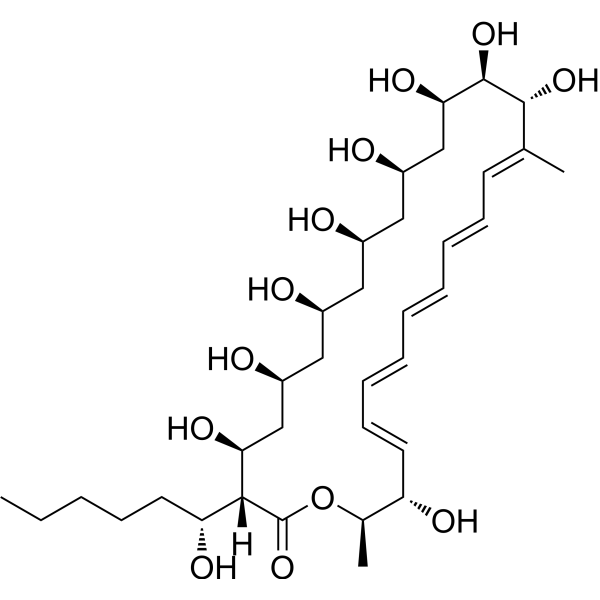
-
- HY-77641
-
|
|
Endogenous Metabolite
|
Metabolic Disease
|
|
Cinnamoylglycine is a glycine conjugate of cinnamic acid and a urinary metabolite in human. Cinnamoylglycine is used as a potential urinary biomarker indicating intact or disrupted colonization resistance during and after antibiotic treatment .
|
-
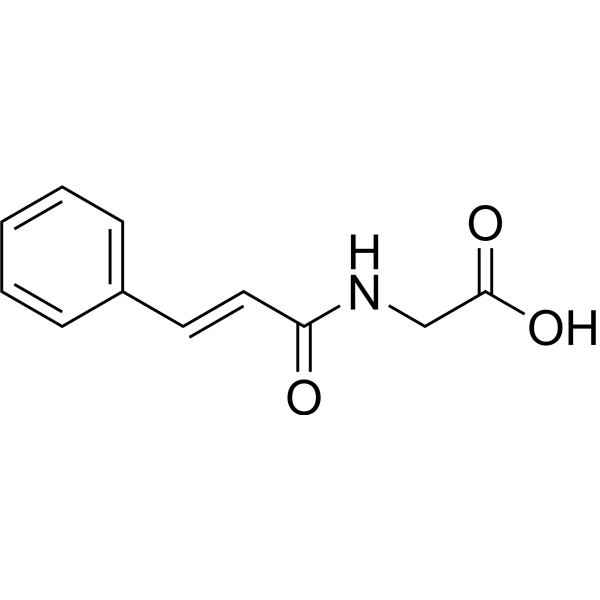
-
- HY-146199
-
|
|
Bacterial
|
Infection
|
|
Antibacterial agent 108 (Compound 1h) is a potent antibacterial agent with a MIC of both 3 μM against MRSA and antibiotic resistance strains .
|
-
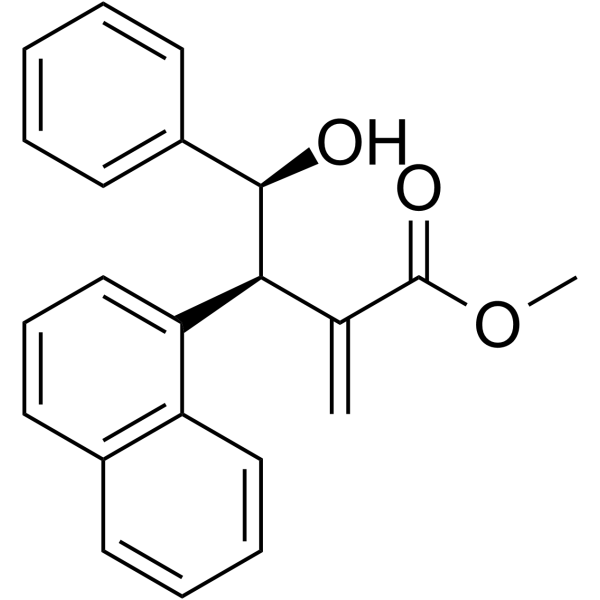
-
- HY-155504
-
|
|
Beta-lactamase
Bacterial
|
Infection
|
|
Metallo-β-lactamase-IN-11 (compound 5f) is a Metallo-β-lactamases (MBLs) inhibitor, potent against bacterial metallophyllactamase CphA (IC50=45 µM). Metallo-β-lactamase-IN-11 (10 µM) inhibits NDM-1 by 49% and AIM-1 by 61%. Metallo-β-lactamase-IN-11 can be used in the research of inhibiting antibiotic resistance .
|
-
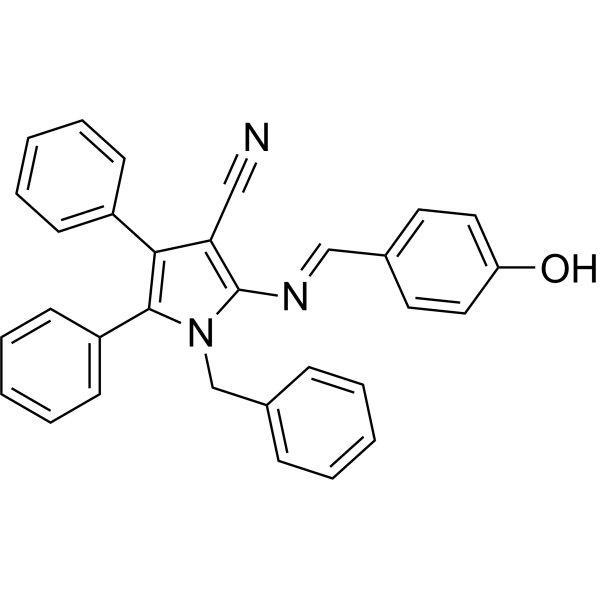
-
- HY-P10027
-
|
|
Antibiotic
Bacterial
|
Infection
|
|
Clovibactin is an antibiotic for drug-resistant bacterial pathogens without detectable resistance. Clovibactin TFA inihibits cell wall synthesis by targeting pyrophosphate of peptidoglycan precursors .
|
-
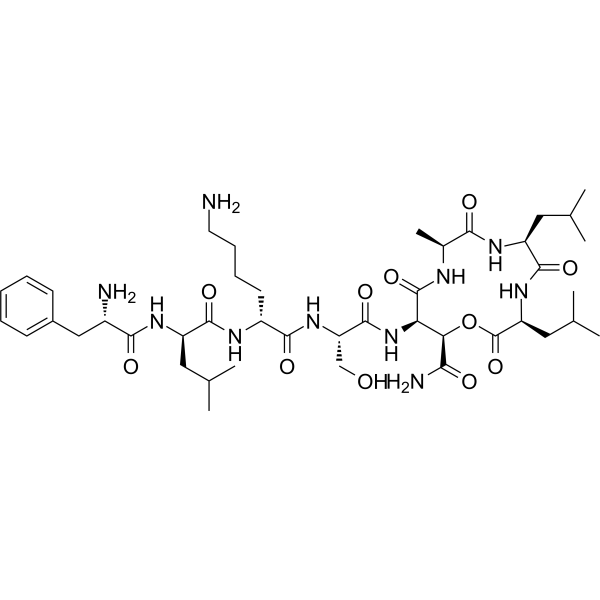
-
- HY-W062216
-
|
|
Bacterial
Arginase
|
Infection
|
|
2-Aminoimidazole is a potent antibiofilm agent that can be used as an adjuvant to antimicrobial. 2-aminoimidazoles disrupts the ability of bacteria to protect themselves by inhibiting biofilm formation and genetically-encoded antibiotic resistance traits. 2-Aminoimidazole is also a weak noncompetitive inhibitor of human arginase I with a Ki of 3.6 mM .
|
-

-
- HY-P1674A
-
|
POL7080 TFA
|
Bacterial
Antibiotic
|
Infection
|
|
Murepavadin (POL7080) (TFA), a 14-amino-acid cyclic peptide, is a highly potent, specific antibiotic. Murepavadin exhibits a potent antimicrobial activity for P. aeruginosa with MIC50 and MIC90 values both of 0.12 mg/L. Murepavadin also can target the lipopolysaccharide transport portin D. Murepavadin can be used for the research of bacterial resistance .
|
-

-
- HY-P1674
-
|
POL7080
|
Bacterial
Antibiotic
|
Infection
|
|
Murepavadin (POL7080), a 14-amino-acid cyclic peptide, is a highly potent, specific antibiotic. Murepavadin exhibits a potent antimicrobial activity for P. aeruginosa with both MIC50 and MIC90 values of 0.12 mg/L. Murepavadin also can target the lipopolysaccharide transport portin D. Murepavadin can be used for the research of bacterial resistance .
|
-
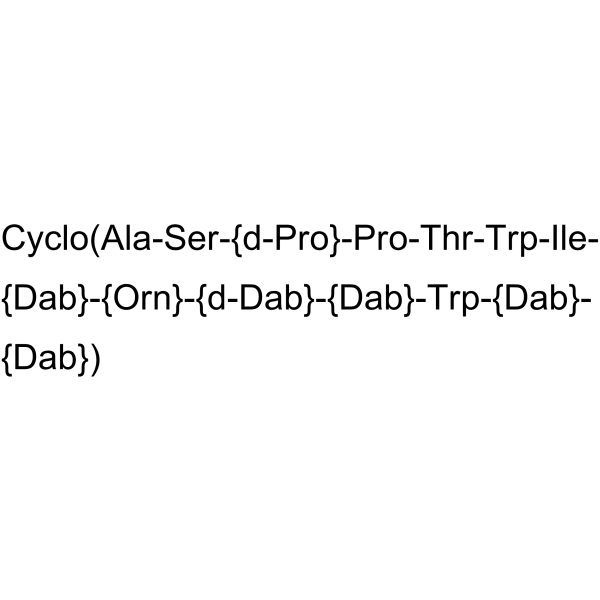
-
- HY-P10211
-
|
|
Antibiotic
Bacterial
|
Infection
|
|
Virgilagicin is a Gram-positive active antibiotic that has a dual polyprenyl phosphate binding mechanism that impedes resistance development .
|
-

-
- HY-P10209
-
|
|
Antibiotic
Bacterial
|
Infection
|
|
Cilagicin, a dodeca-lipodepsipeptide, is a Gram-positive active antibiotic. Cilagicin has a dual polyprenyl phosphate binding mechanism that impedes resistance development .
|
-
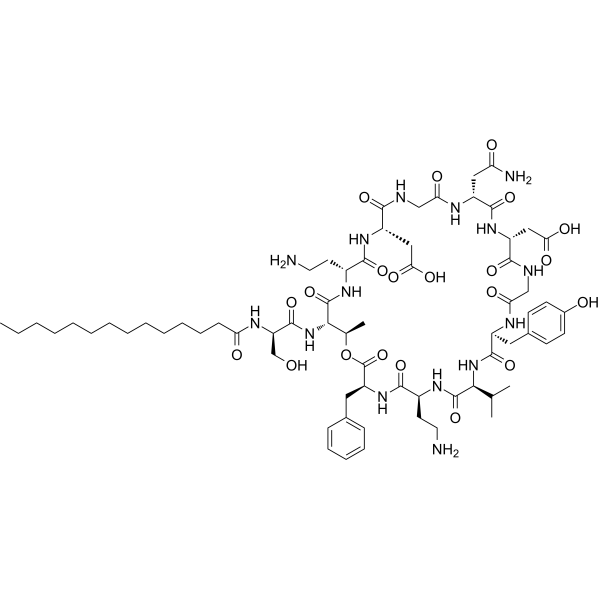
-
- HY-B1329
-
|
Nebramycin II sulfate
|
Bacterial
Antibiotic
|
Infection
|
|
Apramycin (EBL 1003) is an orally active, acidic pH tolerant and aminoglycoside-modifying-enzymes-tolerant aminoglycoside antibiotic which inhibits protein biosynthesis by targeting the bacterial ribosome. Apramycin is a potential anti-drug-resistance antibiotic .
|
-

-
- HY-126906
-
|
|
Antibiotic
P-glycoprotein
|
Cancer
|
|
Milbemycin A4 inhibits P-glycoprotein activity, and reverses multidrug resistance of tumor cells. Milbemycins are a family of macrolide antibiotics with insecticidal and acaricidal activity sup>[2].
|
-
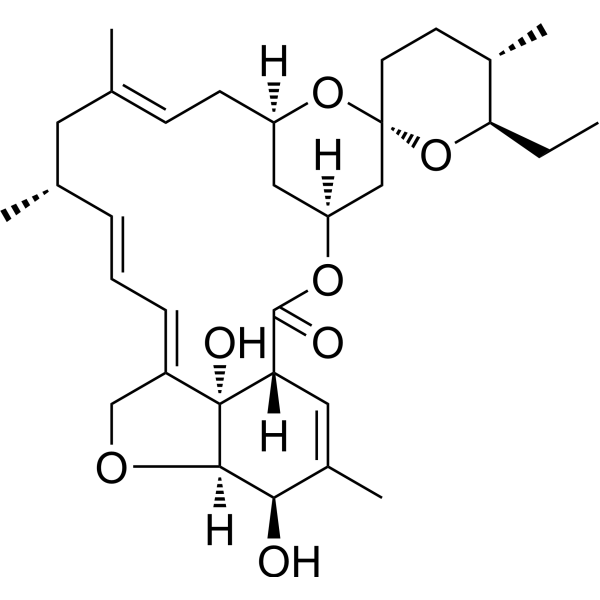
-
- HY-N9386
-
-

-
- HY-100589
-
|
Sch 21420 sulfate
|
|
|
|
Isepamicin sulfate (Sch 21420 sulfate) is a broad spectrum aminoglycoside antibiotic. Isepamicin sulfate exhibits considerable antimicrobial activity against Gram-negative non-fermenters in a region with high antimicrobial resistance .
|
-
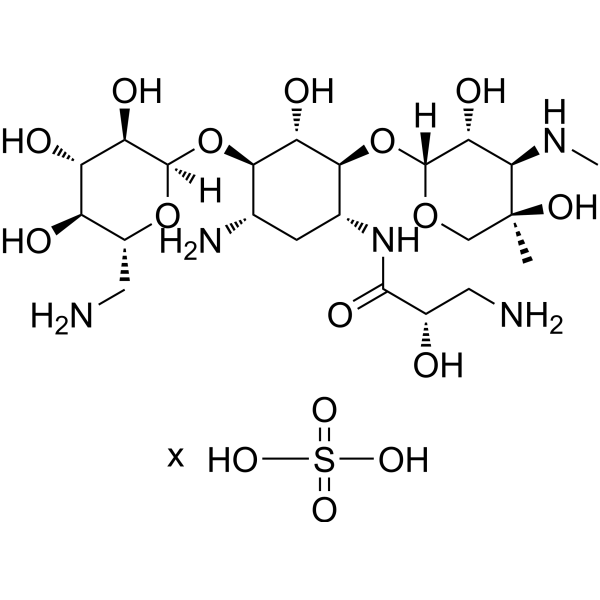
-
- HY-P5620
-
|
|
Bacterial
|
Infection
|
|
DFTamP1 is an antimicrobial peptide against Staphylococcus aureus USA300 activity (MIC is 3.1 μM) .
|
-
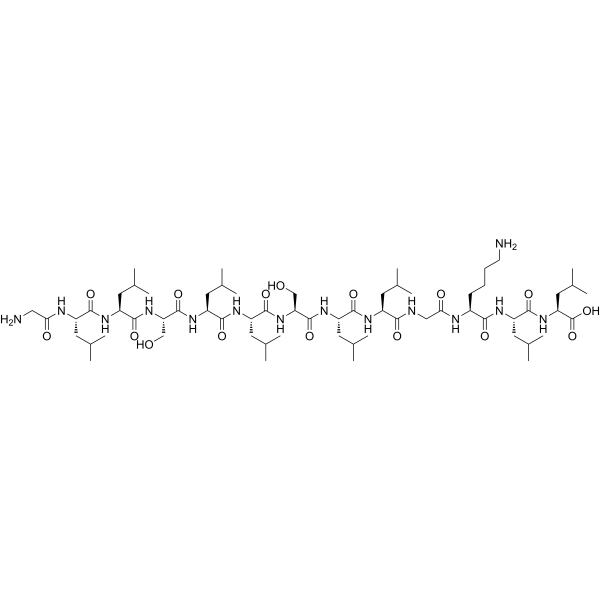
-
- HY-P10210
-
|
|
Antibiotic
Bacterial
|
Infection
|
|
Paenilagicin is a Gram-positive active antibiotic with a unique diphosphorylated prenyl binding mechanism that does not induce drug resistance. Paenilagicin exhibits a MIC value of 2 μg/mL against multidrug-resistant Gram-positive bacteria .
|
-
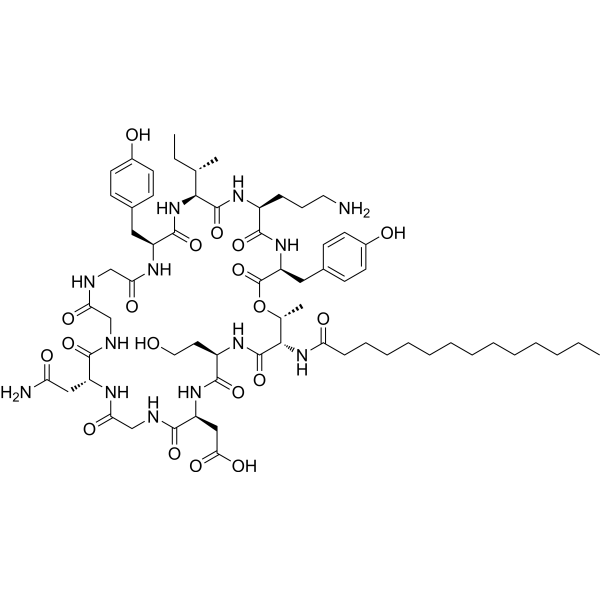
-
- HY-77641S
-
|
|
Endogenous Metabolite
|
Metabolic Disease
|
|
Cinnamoylglycine-d2 is the deuterium labeled Cinnamoylglycine. Cinnamoylglycine is a glycine conjugate of cinnamic acid and a urinary metabolite in human. Cinnamoylglycine is used as a potential urinary biomarker indicating intact or disrupted colonization resistance during and after antibiotic treatment[1].
|
-
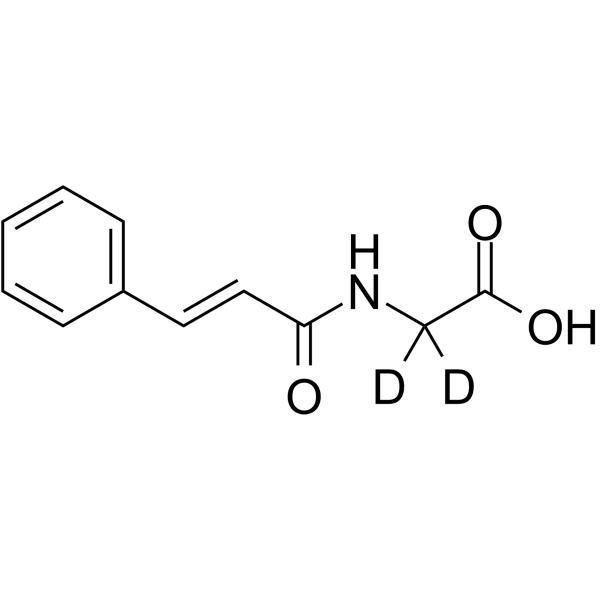
-
- HY-P10027A
-
|
|
Antibiotic
Bacterial
|
Infection
|
|
Clovibactin TFA is the TFA salt form of Clovibactin (HY-P10027). Clovibactin TFA is an antibiotic for drug-resistant bacterial pathogens without detectable resistance. Clovibactin TFA inihibits cell wall synthesis by targeting pyrophosphate of peptidoglycan precursors .
|
-

-
- HY-149333
-
|
|
Bacterial
|
Infection
|
|
BO-1 is a benzoate ester with antibacterial activity. BO-1 inhibits multidrug-resistant Staphylococcus aureus, and acts function synergistically with antibiotic, such as Ciprofloxacin (HY-B0356). BO-1 can reverse the resistance of antibiotic-resistant S. aureus strains, and decreases the level of inflammatory factors IL-6 and C-reactive protein in vivo in mice .
|
-
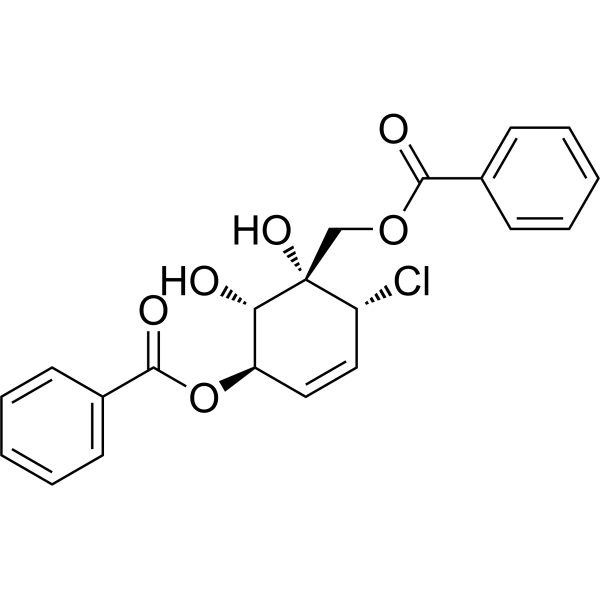
-
- HY-146330
-
|
|
Bacterial
|
Infection
|
|
FtsZ-IN-2 (Compound 19) is an inhibitor of the bacterial cell division protein FtsZ with GTPase inhibitory activity. FtsZ-IN-2 exhibits anti-staphylococcal activity with MIC values of 2 µg/ml for MSSA and MRSA .
|
-
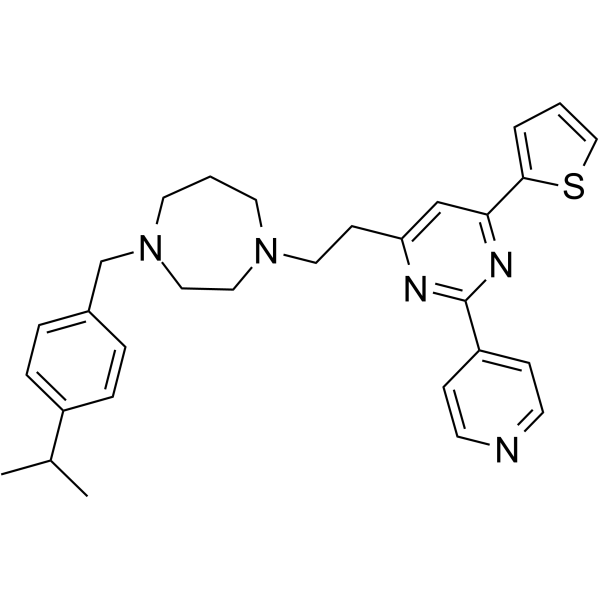
-
- HY-156414
-
-
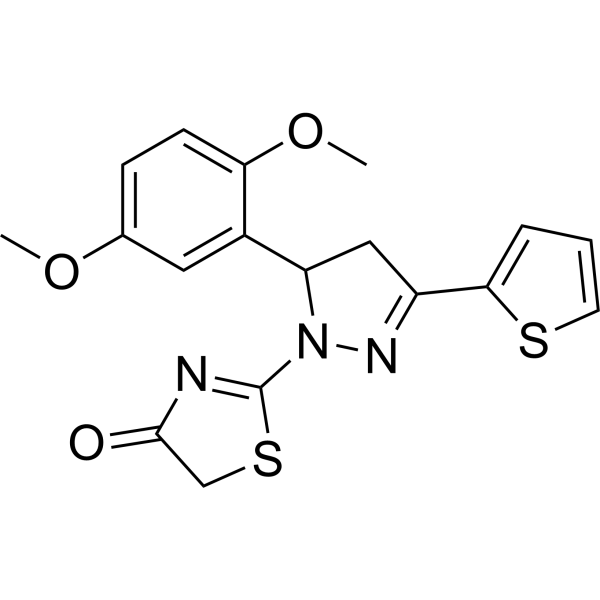
-
- HY-127146
-
|
|
Antibiotic
Bacterial
|
|
|
Platensimycin is an antibiotic produced by S. platensis that inhibits gram-positive bacteria by selectively inhibiting cellular lipid biosynthesis (IC50=0.1 μM). Platensimycin targets the β-ketoacyl-acyl-carrier-protein synthase I/II, FabF/B, an enzyme that participates in the biosynthesis of fatty acids (IC50s=48 nM and 160 nM for S.aureus and E.coli enzymes, respectively). Platensimycin is a promising agent for overcoming antibiotic resistance.
|
-
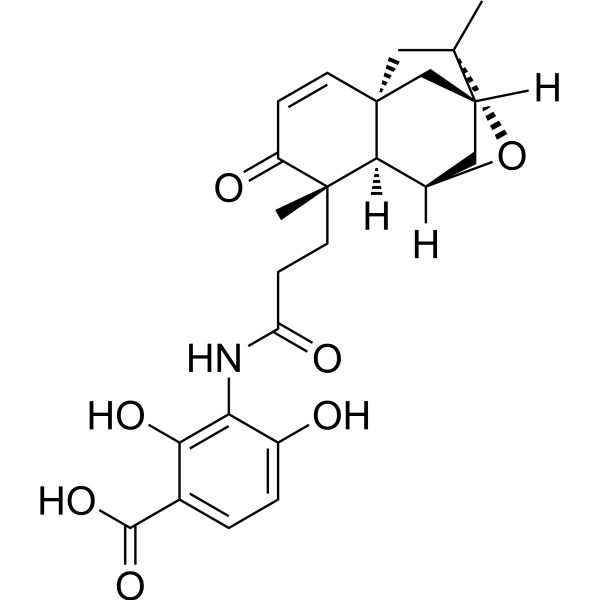
-
- HY-146331
-
|
|
Bacterial
Antibiotic
|
Infection
|
|
PC190723 (Compound 2) is an inhibitor of the bacterial cell division protein FtsZ with an IC50 of 55 ng/ml. FtsZ-IN-3 exhibits anti-staphylococcal activity with MIC values of 1 µg/ml for MSSA and MRSA .
|
-

-
- HY-B1599
-
|
|
Bacterial
Antibiotic
|
Infection
|
|
Chloramphenicol palmitate is an orally active broad spectrum antibiotic and has a broad spectrum of activity against gram positive and gram negative bacteria. Chloramphenicol palmitate inhibits bacterial protein synthesis by blocking the peptidyl transferase step. Chloramphenicol palmitate can be used as bacterial selection agent in transformed cells containing chloramphenicol resistance genes .
|
-

-
- HY-106668
-
|
Sch 21420
|
Antibiotic
Bacterial
|
Infection
|
|
Isepamicin (Sch 21420) is an aminoglycoside antibacterial. Isepamicin has better activity against strains producing type I 6'-acetyltransferase. Isepamicin’s antibacterial spectrum includes Enterobacteriaceae and staphylococci. Anaerobes, Neisseriaceae and streptococci are resistant. Isepamicin exhibits a strong concentration-dependent bactericidal effect, a long post-antibiotic effect (several hours) and induces adaptive resistance .
|
-

-
- HY-B1455
-
|
|
|
|
|
Clindamycin is an orally active and broad-spectrum bacteriostatic lincosamide antibiotic. Clindamycin can inhibit bacterial protein synthesis, possessing the ability to suppress the expression of virulence factors in Staphylococcus aureus at sub-inhibitory concentrations (sub-MICs). Clindamycin resistance results from enzymatic methylation of the antibiotic binding site in the 50S ribosomal subunit (23S rRNA). Clindamycin decreases the production of Panton-Valentine leucocidin (PVL), toxic-shock-staphylococcal toxin (TSST-1) or alpha-haemolysin (Hla). Clindamycin also can be used for researching malaria .
|
-

-
- HY-B1455S
-
|
|
Bacterial
Antibiotic
Parasite
|
Infection
|
|
Clindamycin-d3 (hydrochloride) is the deuterium labeled Clindamycin. Clindamycin is an orally active and broad-spectrum bacteriostatic lincosamide antibiotic. Clindamycin can inhibit bacterial protein synthesis, possessing the ability to suppress the expression of virulence factors in Staphylococcus aureus at sub-inhibitory concentrations (sub-MICs). Clindamycin resistance results from enzymatic methylation of the antibiotic binding site in the 50S ribosomal subunit (23S rRNA). Clindamycin decreases the production of Panton-Valentine leucocidin (PVL), toxic-shock-staphylococcal toxin (TSST-1) or alpha-haemolysin (Hla). Clindamycin also can be used for researching malaria[1][2].
|
-

-
- HY-B1599R
-
|
|
Bacterial
Antibiotic
|
Infection
|
|
Chloramphenicol palmitate (Standard) is the analytical standard of Chloramphenicol palmitate. This product is intended for research and analytical applications. Chloramphenicol palmitate is an orally active broad spectrum antibiotic and has a broad spectrum of activity against gram positive and gram negative bacteria. Chloramphenicol palmitate inhibits bacterial protein synthesis by blocking the peptidyl transferase step. Chloramphenicol palmitate can be used as bacterial selection agent in transformed cells containing chloramphenicol resistance genes .
|
-

-
- HY-116815
-
|
|
Beta-lactamase
Bacterial
|
Infection
Neurological Disease
|
|
Lalistat 1 is a potent, selective, and competitive inhibitor of lysosomal acid lipase (LAL) and against purified human LAL (phLAL) with an IC50 of 68 nM. Lalistat 1 is a inhibitor of immunoglobulin A1 protease (IgA1P) proteases for H. influenzae, has less effects on other serine hydrolases (trypsin or β-lactamase, etc.). Lalistat 1 can be used for the research of niemann-pick type C (NPC) disease .
|
-

-
- HY-N7118
-
|
|
Bacterial
Antibiotic
|
Infection
Cancer
|
|
Clindamycin hydrochloride monohydrate is an oral protein synthesis inhibitory agent that has the ability to suppress the expression of virulence factors in Staphylococcus aureus at sub-inhibitory concentrations (sub-MICs). Clindamycin hydrochloride monohydrate resistance results from enzymatic methylation of the antibiotic binding site in the 50S ribosomal subunit (23S rRNA). Clindamycin hydrochloride monohydrate decreases the production of Panton-Valentine leucocidin (PVL), toxic-shock-staphylococcal toxin (TSST-1) or alpha-haemolysin (Hla) .
|
-

-
- HY-150766
-
|
|
Bacterial
|
Infection
|
|
KPC-2-IN-1, boronic acid derivative, is a potent KPC-2 inhibitor with Ki of 0.032 μM. KPC-2-IN-1 enhances the activity of cefotaxime in KPC-2 expressing E. coli. KPC-2-IN-1 exhibits well tolerated in human HEK-293 cells, which can be used for the study of E. coli resistance to β-lactam antibiotics .
|
-
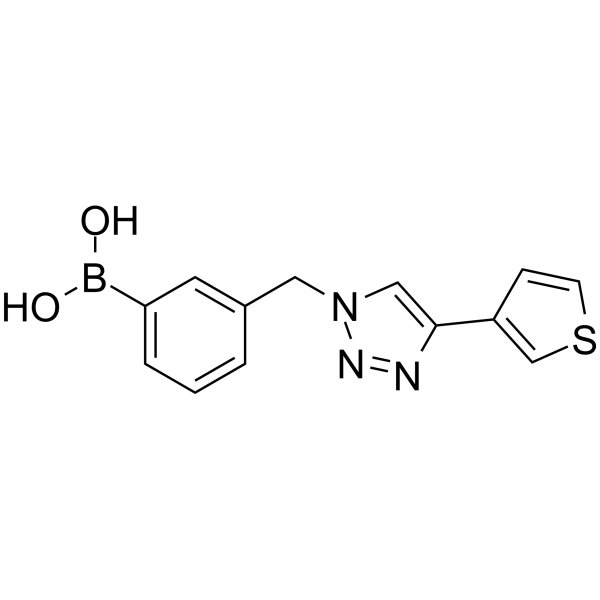
-
- HY-162174
-
|
|
Beta-lactamase
Bacterial
|
Infection
|
|
MBL-IN-2 ((2R, 2R')-5αC) is an inhibitor of Metallo-β-lactamase (MBL) that can inhibit New Delhi Metallo-β-lactamase-1 (NDM-1) with an IC50 of 0.3 μM. MBL-IN-2 ((2R, 2R')-5αC) can be used for the study of resistance to β-lactam antibiotics .
|
-
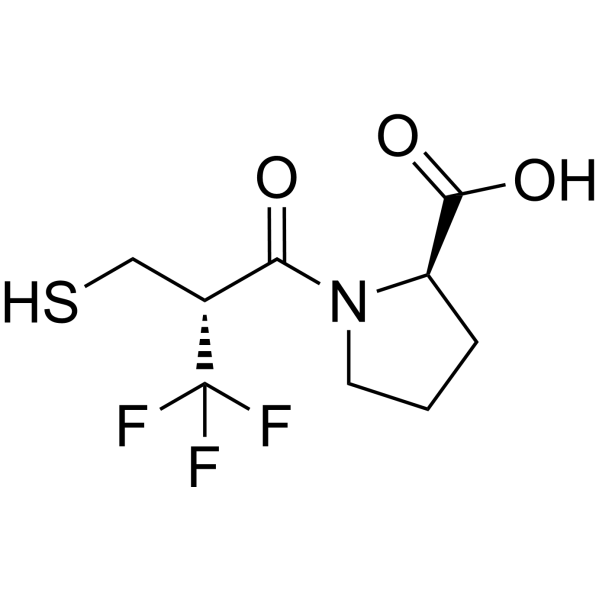
-
- HY-B1455S1
-
|
|
Isotope-Labeled Compounds
Bacterial
Antibiotic
Parasite
|
Infection
|
|
Clindamycin- 13C,d3 is the 13C- and deuterium labeled Clindamycin. Clindamycin is an orally active and broad-spectrum bacteriostatic lincosamide antibiotic. Clindamycin can inhibit bacterial protein synthesis, possessing the ability to suppress the expression of virulence factors in Staphylococcus aureus at sub-inhibitory concentrations (sub-MICs). Clindamycin resistance results from enzymatic methylation of the antibiotic binding site in the 50S ribosomal subunit (23S rRNA). Clindamycin decreases the production of Panton-Valentine leucocidin (PVL), toxic-shock-staphylococcal toxin (TSST-1) or alpha-haemolysin (Hla). Clindamycin also can be used for researching malaria[1][2][3].
|
-

-
- HY-P3078
-
|
|
Bacterial
Antibiotic
|
Infection
|
|
Amphomycin is a lipopeptide antibiotic that inhibits peptidoglycan synthesis and blocks cell wall development. Amphomycin exhibits potent antibacterial activities against methicillin-resistant S. aureus (MRSA), vancomycin-resistant enterococci (VRE), penicillin-gentamicin-erythromycin-resistant S. pneumonia, and linezolid-quinupristin-dalfopristin-resistant enterococci .
|
-

-
- HY-144659
-
|
|
Beta-lactamase
Apoptosis
Bacterial
|
Infection
|
|
Metallo-β-lactamase-IN-5 (compound 5c) is a potent metallo-β-lactamases (MBL) inhibitor. Metallo-β-lactamase-IN-5 shows inhibitory activity against MBLs NDM-1 and VIM-1. Metallo-β-lactamase-IN-5 inhibits HUVECs with an IC50 of 45 μg/mL. Metallo-β-lactamase-IN-5 plus Imipenem exhibits synergistic antimicrobial activity .
|
-
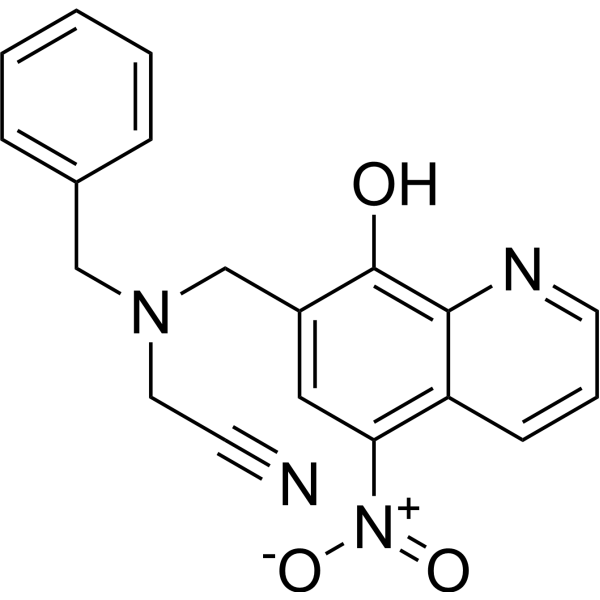
-
- HY-147531
-
|
|
Bacterial
|
Infection
|
|
Antibacterial agent 106 (compound 8) is an orally active and potent antibacterial agent with antibiofilm activity. Antibacterial agent 106 shows potent antibacterial effect against multi-agent resistant (MDR)-Gram positive pathogens. Antibacterial agent 106 is highly effective in clearing 99.7% of the intracellular methicillin-resistant S. aureus (MRSA) harbored inside macrophages . Antibacterial agent 106 is a click chemistry reagent, it contains an Alkyne group and can undergo copper-catalyzed azide-alkyne cycloaddition (CuAAc) with molecules containing Azide groups.
|
-
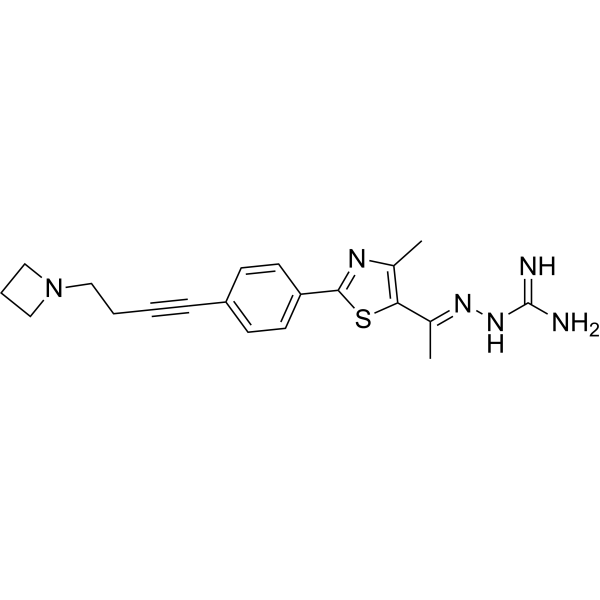
-
- HY-147674
-
|
|
Aminoacyl-tRNA Synthetase
|
Infection
|
|
Isoleucyl tRNA synthetase-IN-2 (compound 36a) is a potent and selective isoleucyl-tRNA synthetase (IleRS) inhibitor, with a Ki,app of 114 nM .
|
-
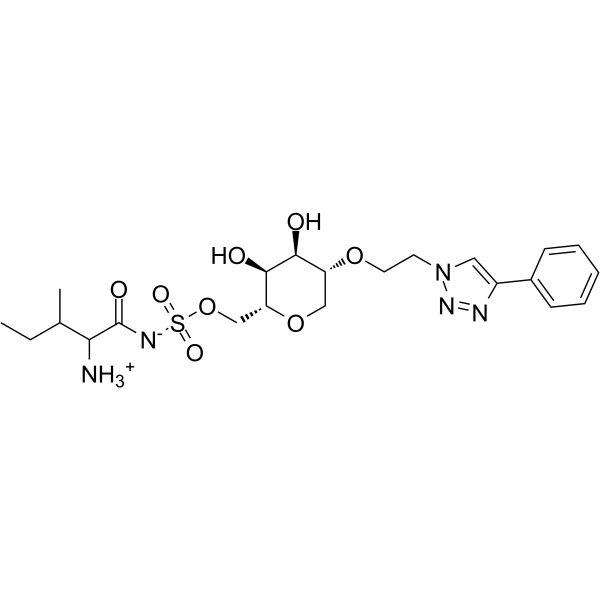
-
- HY-147671
-
-

-
- HY-147672
-
-

-
- HY-103251
-
|
LpxC-4
|
Antibiotic
Bacterial
|
Infection
|
|
PF-5081090 (LpxC-4) is a potent LpxC inhibitor, is a rapidly bactericidal with broad-spectrum activity. PF-5081090 serves as a regulator of lipid A biosynthesis in Gram-negative pathogens .
|
-
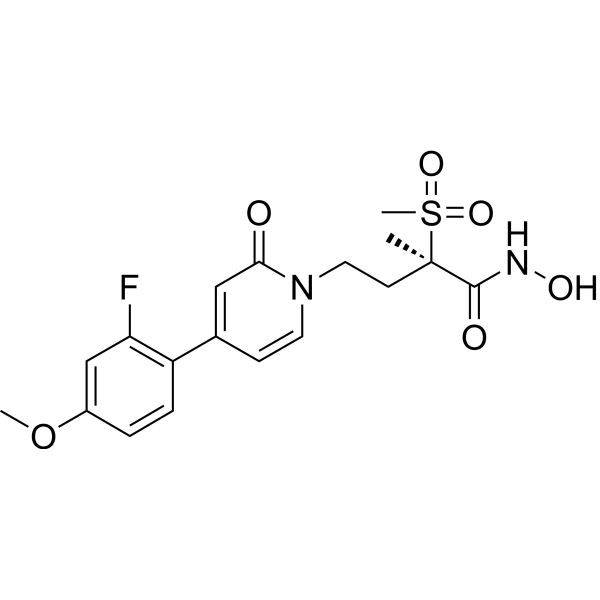
-
-
HY-L169
-
|
|
325 compounds
|
|
Resistance refers to the decrease in the effectiveness of drugs in treating diseases or symptoms. Due to the increasing global antibiotic resistance, it may threaten our ability to treat common infectious diseases. Drug resistance is also the main cause of chemotherapy failure in malignant tumors. In approximately 50% of cases, drug resistance exists even before chemotherapy begins. There are many mechanisms of anticancer drug resistance, including increased protein expression that leads to drug removal, mutations in drug binding sites, recovery of tumor protein production, and pre-existing genetic heterogeneity in tumor cell populations. In addition, the issue of drug resistance seems to have affected the development of new anticancer drugs. Drug resistance may be caused by various conditions, such as mutations, epigenetic modifications, and upregulation of drug efflux protein expression. Overcoming multidrug resistance in cancer treatment is becoming increasingly important.
MCE designs a unique collection of 325 anti-drug-resistant compounds. It is a good tool to be used for research on cancer and other diseases.
|
| Cat. No. |
Product Name |
Target |
Research Area |
-
- HY-P1674A
-
|
POL7080 TFA
|
Bacterial
Antibiotic
|
Infection
|
|
Murepavadin (POL7080) (TFA), a 14-amino-acid cyclic peptide, is a highly potent, specific antibiotic. Murepavadin exhibits a potent antimicrobial activity for P. aeruginosa with MIC50 and MIC90 values both of 0.12 mg/L. Murepavadin also can target the lipopolysaccharide transport portin D. Murepavadin can be used for the research of bacterial resistance .
|
-
- HY-P10027
-
|
|
Antibiotic
Bacterial
|
Infection
|
|
Clovibactin is an antibiotic for drug-resistant bacterial pathogens without detectable resistance. Clovibactin TFA inihibits cell wall synthesis by targeting pyrophosphate of peptidoglycan precursors .
|
-
- HY-P1674
-
|
POL7080
|
Bacterial
Antibiotic
|
Infection
|
|
Murepavadin (POL7080), a 14-amino-acid cyclic peptide, is a highly potent, specific antibiotic. Murepavadin exhibits a potent antimicrobial activity for P. aeruginosa with both MIC50 and MIC90 values of 0.12 mg/L. Murepavadin also can target the lipopolysaccharide transport portin D. Murepavadin can be used for the research of bacterial resistance .
|
-
- HY-P10211
-
|
|
Antibiotic
Bacterial
|
Infection
|
|
Virgilagicin is a Gram-positive active antibiotic that has a dual polyprenyl phosphate binding mechanism that impedes resistance development .
|
-
- HY-P10209
-
|
|
Antibiotic
Bacterial
|
Infection
|
|
Cilagicin, a dodeca-lipodepsipeptide, is a Gram-positive active antibiotic. Cilagicin has a dual polyprenyl phosphate binding mechanism that impedes resistance development .
|
-
- HY-P5620
-
|
|
Bacterial
|
Infection
|
|
DFTamP1 is an antimicrobial peptide against Staphylococcus aureus USA300 activity (MIC is 3.1 μM) .
|
-
- HY-P10210
-
|
|
Antibiotic
Bacterial
|
Infection
|
|
Paenilagicin is a Gram-positive active antibiotic with a unique diphosphorylated prenyl binding mechanism that does not induce drug resistance. Paenilagicin exhibits a MIC value of 2 μg/mL against multidrug-resistant Gram-positive bacteria .
|
-
- HY-P10027A
-
|
|
Antibiotic
Bacterial
|
Infection
|
|
Clovibactin TFA is the TFA salt form of Clovibactin (HY-P10027). Clovibactin TFA is an antibiotic for drug-resistant bacterial pathogens without detectable resistance. Clovibactin TFA inihibits cell wall synthesis by targeting pyrophosphate of peptidoglycan precursors .
|
-
- HY-P3078
-
|
|
Bacterial
Antibiotic
|
Infection
|
|
Amphomycin is a lipopeptide antibiotic that inhibits peptidoglycan synthesis and blocks cell wall development. Amphomycin exhibits potent antibacterial activities against methicillin-resistant S. aureus (MRSA), vancomycin-resistant enterococci (VRE), penicillin-gentamicin-erythromycin-resistant S. pneumonia, and linezolid-quinupristin-dalfopristin-resistant enterococci .
|
| Cat. No. |
Product Name |
Category |
Target |
Chemical Structure |
| Cat. No. |
Product Name |
Chemical Structure |
-
- HY-B1455S1
-
|
|
|
Clindamycin- 13C,d3 is the 13C- and deuterium labeled Clindamycin. Clindamycin is an orally active and broad-spectrum bacteriostatic lincosamide antibiotic. Clindamycin can inhibit bacterial protein synthesis, possessing the ability to suppress the expression of virulence factors in Staphylococcus aureus at sub-inhibitory concentrations (sub-MICs). Clindamycin resistance results from enzymatic methylation of the antibiotic binding site in the 50S ribosomal subunit (23S rRNA). Clindamycin decreases the production of Panton-Valentine leucocidin (PVL), toxic-shock-staphylococcal toxin (TSST-1) or alpha-haemolysin (Hla). Clindamycin also can be used for researching malaria[1][2][3].
|
-

-
- HY-77641S
-
|
|
|
Cinnamoylglycine-d2 is the deuterium labeled Cinnamoylglycine. Cinnamoylglycine is a glycine conjugate of cinnamic acid and a urinary metabolite in human. Cinnamoylglycine is used as a potential urinary biomarker indicating intact or disrupted colonization resistance during and after antibiotic treatment[1].
|
-

-
- HY-B1455S
-
|
|
|
Clindamycin-d3 (hydrochloride) is the deuterium labeled Clindamycin. Clindamycin is an orally active and broad-spectrum bacteriostatic lincosamide antibiotic. Clindamycin can inhibit bacterial protein synthesis, possessing the ability to suppress the expression of virulence factors in Staphylococcus aureus at sub-inhibitory concentrations (sub-MICs). Clindamycin resistance results from enzymatic methylation of the antibiotic binding site in the 50S ribosomal subunit (23S rRNA). Clindamycin decreases the production of Panton-Valentine leucocidin (PVL), toxic-shock-staphylococcal toxin (TSST-1) or alpha-haemolysin (Hla). Clindamycin also can be used for researching malaria[1][2].
|
-

Your information is safe with us. * Required Fields.
Inquiry Information
- Product Name:
- Cat. No.:
- Quantity:
- MCE Japan Authorized Agent:
















































